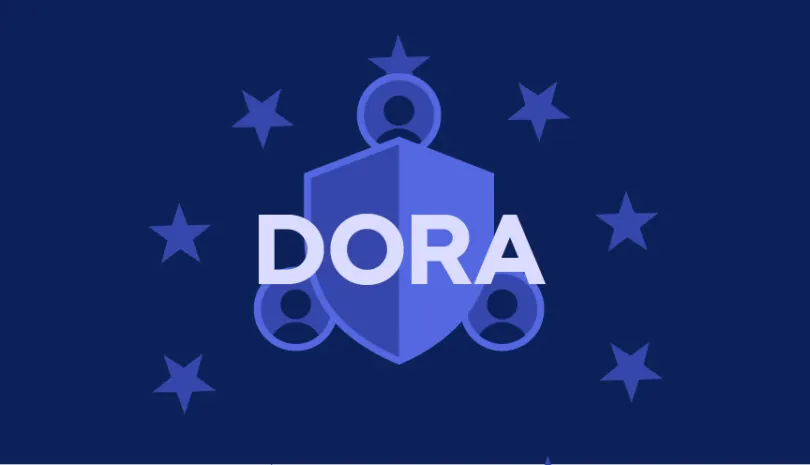The Digital Operational Resilience Act (DORA) has reshaped how financial institutions and their ICT providers approach cyber risk in the EU. It’s a serious regulation that sets a clear, enforceable standard for how organizations must prepare for, withstand, and recover from digital disruptions.
Why does this matter? Because DORA applies broadly, from traditional banks and insurance firms to cloud service providers and fintech startups. If you’re part of the financial ecosystem in the EU, DORA is now part of your daily reality.
In this blog, we’ll break down DORA’s five core compliance pillars, ICT Risk Management, Incident Reporting, Resilience Testing, Third-Party Risk Management, and Information Sharing, and explain what each one means in practical terms. Whether you’re just getting started or refining your compliance program post-deadline, we’ll help you cut through the noise and focus on what matters most: building real operational resilience.
DORA Compliance Requirement Pillar 1: ICT Risk Management
At the heart of DORA is the need for organizations to proactively manage information and communication technology (ICT) risks. This first pillar calls for a structured framework to identify, assess, mitigate, and continuously monitor ICT risks across the business. That means going beyond basic IT hygiene, embedding risk awareness into every stage of the digital lifecycle. From infrastructure vulnerabilities to human error and third-party dependencies, financial entities must have clear governance, real-time monitoring, and response protocols in place. The goal isn’t just risk reduction, it’s operational continuity in the face of digital disruption.
ICT Risk Management Key Requirements
Effective ICT risk management under DORA begins with strong governance and clearly defined accountability. Organizations must appoint responsible roles, define reporting lines, and ensure leadership involvement in oversight. Just as critical is the need to establish risk tolerance thresholds, clear guidelines on what level of ICT risk is acceptable, and when action is required. Additionally, entities must develop incident classification systems that outline the severity of an event and its potential impact. These thresholds ensure consistency and clarity, making it easier to prioritize responses and communicate with internal stakeholders and regulators alike.
ICT Risk Management: Practical Steps
To operationalize this pillar, start by developing or updating your ICT risk management policies, ensuring they align with DORA’s expectations. These should cover governance, risk appetite, classification rules, and escalation processes. Next, conduct regular risk assessments, tabletop exercises, and simulations to identify vulnerabilities and test your organization’s readiness. These exercises help uncover gaps in controls or communication while reinforcing a culture of resilience. Finally, ensure risk data is continuously monitored and reported across systems, vendors, and departments, turning policy into practice.
DORA Compliance Requirement Pillar 2: Incident Reporting
This pillar requires organizations to adopt a standardized, timely approach to reporting major ICT-related incidents to regulators. The goal is not only to ensure transparency but also to allow authorities to understand systemic risk and respond effectively. Financial entities must define what constitutes a reportable incident, detect it promptly, and escalate through a well-orchestrated chain of communication. DORA emphasizes the importance of structured, phased reporting, enabling regulators to get early insights without waiting for a full postmortem. The end goal: speed, clarity, and accountability during high-stakes disruptions.
Incident Reporting Key Requirements
Under DORA, organizations must define classification criteria for ICT-related incidents, focusing on factors like service disruption, data loss, customer impact, and financial harm. Once identified, incidents must be reported in three structured phases: an initial notification within hours or days (depending on severity), a more detailed intermediate report, and a final incident report with root cause and lessons learned. These timelines are not optional; they’re regulatory expectations that require real-time detection, coordination, and well-rehearsed procedures across teams.
Incident Reporting: Practical Steps
To meet DORA’s reporting standards, organizations should first implement real-time incident detection and alerting tools, including threat intelligence, behavioral analytics, and system monitoring. Next, build or refine your internal incident response framework, assigning clear responsibilities and escalation paths. This should include defined SLAs, communication templates, and regulator-facing workflows. Don’t wait for an actual event; test these protocols regularly through simulation exercises to ensure teams can act fast, stay aligned, and provide the required updates to regulators on time.
DORA Compliance Requirement Pillar 3: Digital Operational Resilience Testing
DORA doesn’t just require plans, it demands proof. This pillar focuses on regular, rigorous testing of ICT systems to evaluate how well your organization can withstand and recover from cyber incidents. Testing should simulate real-world threats and operational stressors, particularly for critical systems. The goal is to ensure resilience isn’t theoretical but tested and validated. Financial entities must be able to demonstrate preparedness, spot vulnerabilities before attackers do, and continuously improve response capabilities based on test outcomes.
Digital Operational Resilience Testing: Key Requirements
DORA outlines two core testing methods. First, threat-led penetration testing (TLPT), required for critical systems, involves ethical hackers simulating advanced cyberattacks to uncover hidden vulnerabilities. Second, scenario-based testing challenges internal teams to respond to realistic incident simulations, ranging from ransomware outbreaks to vendor outages. Both testing types must be conducted regularly and reflect evolving risk landscapes. Importantly, TLPTs must be carried out by certified, independent teams, ensuring impartiality and regulatory credibility.
Digital Operational Resilience Testing: Practical Steps
Start by identifying your most critical ICT systems, then partner with certified red teams to perform TLPTs. These tests should mimic sophisticated threat actors targeting your business. Additionally, conduct tabletop or live scenario tests with your internal response teams to evaluate readiness. After each exercise, document lessons learned, mitigation steps, and follow-up actions. This isn’t just about passing a test; it’s about building operational muscle memory and continuously improving your digital resilience strategy.
DORA Compliance Requirement Pillar 4: ICT Third-Party Risk Management
Outsourcing ICT services doesn’t mean outsourcing responsibility. This pillar focuses on the risks introduced by third-party vendors and service providers. Under DORA, organizations must treat third-party risk management (TPRM) as a strategic imperative, not a one-time onboarding task. That means evaluating vendors before contracts are signed, continuously monitoring them throughout the relationship, and ensuring resilience even if a vendor fails. This is especially critical in complex supply chains where indirect dependencies can trigger cascading impacts.
ICT Third-Party Risk Management: Key Requirements
DORA requires financial entities to conduct due diligence before entering into contracts, assessing ICT providers for security posture, regulatory alignment, and resilience. But it doesn’t stop there. Organizations must also monitor vendor performance and risk continuously through SLAs, risk indicators, and periodic assessments. Finally, they must have exit and continuity plans, ensuring the business can continue uninterrupted if a vendor is compromised or needs to be replaced.
ICT Third-Party Risk Management: Practical Steps
Begin by creating and maintaining an up-to-date inventory of all ICT third parties, including subcontractors. Classify vendors based on criticality and assign appropriate oversight. During contract negotiations, include DORA-specific clauses covering risk monitoring, breach notification, and access to testing results. Ensure your vendor risk management tools can track performance, automate reassessments, and flag concerns early, allowing you to stay ahead of third-party risks rather than just react to them.
DORA Compliance Requirement Pillar 5: Information Sharing
This final pillar of DORA promotes a culture of collaboration over competition. Financial and ICT-related entities are encouraged to voluntarily exchange cyber threat intelligence, lessons learned, and best practices to improve sector-wide resilience. While not mandatory, effective information sharing helps detect emerging threats faster, understand common attack vectors, and build collective defenses. When done right, it creates a network of organizations that are stronger together, without compromising data privacy or business confidentiality.
Information Sharing: Key Requirements
DORA supports the voluntary participation in trusted threat intelligence-sharing communities, especially those focused on financial services. These exchanges must always align with data protection laws, including GDPR, to prevent misuse or exposure of sensitive information. Entities are expected to apply governance around what is shared, how it’s shared, and with whom, ensuring confidentiality, proportionality, and legal compliance at every step.
Information Sharing: Practical Steps
Start by joining or forming a trusted information-sharing group, such as an ISAC (Information Sharing and Analysis Center) or local EU-focused consortium. Develop internal policies that define what types of information can be shared and under what circumstances. Assign dedicated roles for vetting, redacting, and securely transmitting data. These steps not only strengthen your defenses but also contribute to the resilience of the entire financial ecosystem.
DORA Compliance Requirements: Creating a Resilient Digital Ecosystem
DORA isn’t just about ticking compliance boxes, it’s about building a digitally resilient ecosystem that can withstand, adapt to, and recover from disruption. At the heart of the regulation are five core pillars that guide financial entities toward long-term operational strength:
- ICT Risk Management helps identify vulnerabilities and prevent incidents before they occur.
- Incident Reporting establishes transparency and regulatory accountability.
- Digital Resilience Testing ensures your systems and teams are truly prepared for real-world threats.
- Third-Party Risk Management extends resilience to your entire supply chain, including critical ICT vendors and subcontractors.
- Information Sharing promotes collective defense by enabling collaboration across the financial sector.
Together, these pillars form a comprehensive, forward-looking framework for operational resilience. Now that DORA is in effect, organizations must assess their readiness across all five areas. Ask yourself: Where are the gaps? What’s already covered? What needs additional investment or refinement?
Taking a proactive approach today means less risk, fewer surprises, and greater trust from stakeholders tomorrow. Book a demo with Panorays to see how our platform can help your organization achieve full DORA compliance while strengthening digital resilience at scale.
DORA Compliance Requirements FAQs
-
The Digital Operational Resilience Act (DORA) applies to a broad range of financial entities operating within the European Union. This includes banks, credit institutions, insurance companies, investment firms, payment service providers, and crypto-asset service providers. It also extends to critical third-party ICT service providers, even if they are located outside the EU, as long as they support EU-based financial institutions. Unlike other frameworks that may only affect larger firms, DORA applies regardless of organizational size, emphasizing that operational resilience is a shared responsibility across the financial ecosystem.
-
DORA mandates a proactive and continuous approach to third-party risk management. Financial entities must identify, assess, monitor, and mitigate ICT-related risks throughout their entire supply chain, including subcontractors and downstream service providers. This means conducting due diligence, maintaining up-to-date risk registers, and ensuring contracts include clauses for resilience testing, incident reporting, and termination rights.
-
Organizations must report major ICT-related incidents that affect the confidentiality, integrity, or availability of their systems and services. This includes cybersecurity breaches, significant outages, and disruptions with potential regulatory or customer impact. Reports must follow standardized classifications and be submitted within strict timelines to the relevant competent authority.


